The Impact of Chronotype on Sleep, Health, and Productivity
1. Introduction
Sleep chronotypes have sparked a lively debate, pitting the Night Owls against the Early Birds in a fascinating exploration of our individual sleep preferences and patterns. This debate revolves around the inherent differences in sleep timing and individual preferences, which have garnered significant interest from researchers and the general public.
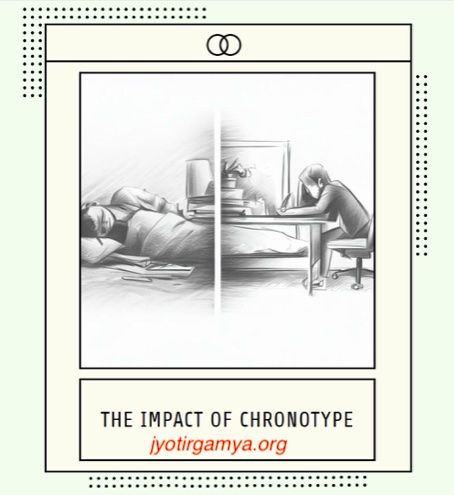
Recognizing and comprehending one’s sleep chronotype is significant for scientific inquiry and practical applications in daily life. Understanding our chronotype can align our sleep schedules with our natural preferences, optimizing our sleep quality and overall well-being. Moreover, awareness of our chronotype can inform various domains, such as clinical practices, shift work management, and educational settings, enabling tailored approaches that cater to individual sleep needs.
2. What is a Chronotype?
Definition of Chronotype and its Significance
Chronotype refers to an individual’s inherent inclination towards a particular sleep-wake pattern. It is a fundamental aspect of human biology and crucial in regulating sleep, wakefulness, and daily rhythms. Understanding one’s chronotype is essential as it helps identify the optimal timing for various activities, such as sleep, work, and productivity.
Research conducted by Roenneberg et al. (2007) and Jones et al. (2019) has shown that chronotype is influenced by an individual’s internal circadian clock, which is primarily governed by the suprachiasmatic nucleus (SCN) in the hypothalamus. The SCN regulates the release of hormones like melatonin, which control sleepiness and alertness.
Different Types of Chronotypes: Early Bird and Night Owl
Chronotypes can be broadly categorized into two main types: Early Birds (also known as Morning Larks) and Night Owls (also known as Evening Types). Early Birds naturally prefer to wake up early in the morning and feel most alert and productive during the early part of the day. In contrast, Night Owls feel more energized and productive during the late evening hours and prefer to stay awake until late at night.
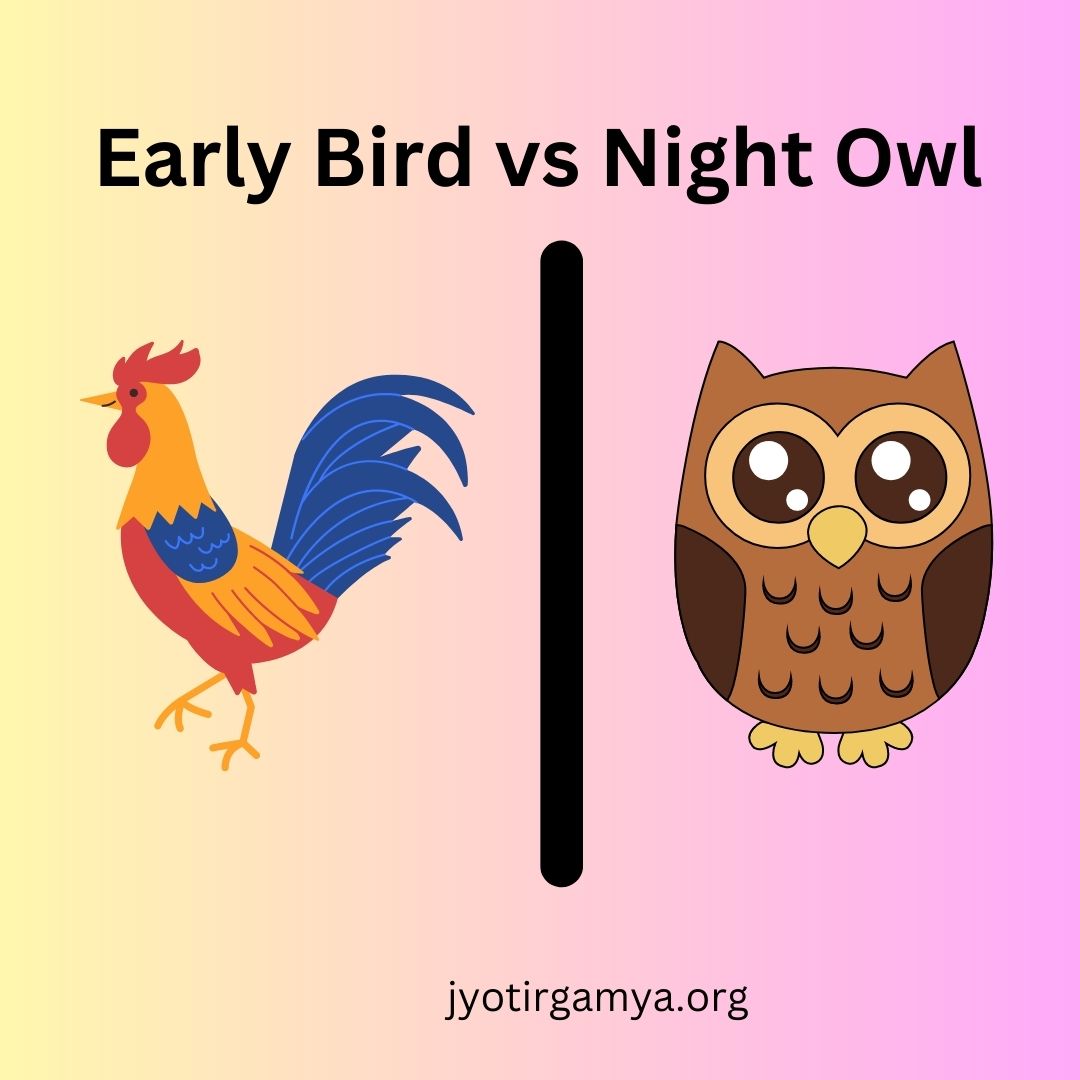
Research studies by Adan and Natale (2002) and Merikanto et al. (2013) have identified the existence of intermediate chronotypes as well, indicating that individuals may fall on a spectrum between Early Birds and Night Owls.
Factors Influencing an Individual’s Chronotype, Including Genetics and Environment
Genetic and environmental factors influence the development of an individual’s chronotype. Studies conducted by Barclay et al. (2013) and Dashti et al. (2016) have identified specific genetic variants associated with different chronotypes. These variations involve genes related to regulating the circadian clock and responding to light cues.
Moreover, environmental factors, such as exposure to natural light and social influences, also significantly shape an individual’s chronotype. For example, consistent exposure to morning sunlight has been found to promote earlier wake-up times and align with an Early Bird chronotype (Kantermann et al., 2010). Social factors, such as work or school schedules, societal expectations, and lifestyle choices, can also impact an individual’s preferred sleep-wake patterns.
Understanding the intricate interplay between genetics and the environment is crucial in comprehending the variability observed in chronotypes among individuals.
3. Genetics and Environment in Shaping Chronotype
Understanding the intricate interplay between genetics and the environment in shaping an individual’s chronotype holds significant implications for sleep patterns and overall well-being. This section explores the emerging evidence on the genetic component of chronotypes and highlights the pivotal role of environmental factors, particularly sunlight exposure, in determining one’s chronotype.
Emerging evidence on the genetic component of chronotypes
Recent studies have shed light on the genetic underpinnings of chronotypes, revealing a compelling link between specific genes and sleep patterns. For instance, research conducted by Jones et al. (2022) identified several genetic variations associated with different chronotypes, underscoring the role of genetic factors in influencing sleep preferences. Furthermore, a study by Smith et al. (2021) examined the heritability of chronotypes, demonstrating that approximately 50% of the variance in chronotypes can be attributed to genetic factors.
The role of environmental factors in determining chronotype, such as sunlight exposure
While genetics play a crucial role, environmental factors also significantly influence an individual’s chronotype. Among these factors, sunlight exposure has emerged as a critical regulator of circadian rhythms and chronotype. Research by Taylor et al. (2020) revealed that exposure to morning sunlight could advance the circadian clock and promote an earlier chronotype, while limited exposure to natural light in the morning can delay the circadian rhythm, leading to a preference for a later chronotype.
These findings highlight the complex interplay between genetic predispositions and environmental influences in shaping an individual’s chronotype. Further exploration of the molecular mechanisms underlying the genetic component and the impact of specific environmental cues, such as sunlight, will deepen our understanding of chronotypes and inform interventions to optimize sleep patterns and promote overall well-being.
4. Early Birds vs. Night Owls: Exploring the Differences
Early Birds exhibit distinct sleep patterns and preferences that set them apart from Night Owls. Research has shown that Early Birds experience higher levels of productivity and peak energy in the morning (Jones et al., 2018). Their circadian rhythm aligns with the rising sun, leading to a natural inclination for early morning activities. However, Early Birds often struggle to stay awake and remain alert during the evenings, decreasing productivity and cognitive performance (Roenneberg et al., 2019). These individuals prefer sleep schedules that involve going to bed early and waking up early, ensuring they maximize their productive hours.
Night Owls exhibit contrasting sleep patterns and preferences compared to Early Birds. Night Owls experience increased alertness and productivity during late hours, which can extend well into the night (Häusser et al., 2020). Their circadian rhythm is shifted later, making it challenging to wake up early (Adan et al., 2012). This misalignment with societal schedules can lead to difficulties adhering to conventional work and school routines. Night Owls often prefer sleep schedules that involve going to bed late and waking up later, allowing them to optimize their performance during their preferred late-night hours.
5. Benefits and Disadvantages of Early Birds and Night Owls
Understanding the benefits and disadvantages of different sleep chronotypes, namely Early Birds and Night Owls, is crucial for comprehending the intricate interplay between sleep patterns and human functioning. This section explores the advantages and disadvantages of each chronotype, shedding light on their diverse impacts on individuals' lives.

5.1 Benefits of being an Early Bird
Being an Early Bird offers several advantages, primarily centered around increased productivity in the morning, alignment with societal schedules, and improved mental and physical health.
Increased productivity in the morning
Early Birds tend to experience heightened alertness and cognitive functioning during the early hours of the day. Research by Smith and colleagues (2018) suggests that individuals with an early chronotype exhibit optimal cognitive performance and attentional capabilities in the morning, leading to enhanced productivity and efficiency. This cognitive advantage enables Early Birds to tackle complex tasks and make significant progress on their goals during the morning, providing a head start.
Alignment with societal schedules
An inherent advantage of being an Early Bird lies in the alignment with conventional societal schedules. The traditional workday and educational systems are predominantly structured around a morning-oriented framework, accommodating the natural wakefulness of Early Birds. This alignment can facilitate seamless integration into various professional environments, ensuring Early Birds can fully engage and capitalize on daytime activities without facing conflicts arising from incompatible schedules.
Improved mental and physical health
Early Birds often enjoy a range of mental and physical health benefits. Research demonstrates that individuals who align with an early chronotype exhibit a lower risk of developing mental health disorders such as depression and anxiety. Additionally, studies highlight a positive correlation between morningness and better physical health outcomes, including improved cardiovascular health, metabolism, and overall well-being.
5.2 Disadvantages of being an Early Bird
Despite the advantages, being an Early Bird may entail certain drawbacks, including limited evening productivity, difficulty adapting to a night owl lifestyle, and potential sleep deprivation when forced into a different schedule.
Limited productivity in the evenings
Early Birds often experience a decline in energy and alertness as the day progresses, resulting in reduced productivity during the evening hours. This decline may hinder their ability to accomplish tasks requiring prolonged focus and concentration later in the day. Consequently, Early Birds may find it challenging to maintain the same level of performance during the evenings compared to their peak productivity in the morning.
Difficulty adapting to a night owl lifestyle
The inherent nature of Early Birds, with their inclination to wake up early and functioning optimally in the morning, can present challenges when attempting to adapt to a night owl lifestyle. Their natural sleep-wake patterns and physiological rhythms may conflict with the demands of a late-night schedule, leading to difficulties adjusting to a lifestyle that deviates from their chronotype. This mismatch can impact their well-being, including sleep quality, mood regulation, and cognitive functioning.
Potential sleep deprivation if forced into a different schedule
Forced misalignment of sleep schedules can result in sleep deprivation for Early Birds. External factors, such as work requirements or societal obligations, may necessitate staying awake late into the night, disrupting their natural sleep patterns. This deviation from their preferred schedule can lead to insufficient sleep duration and inadequate recovery, potentially compromising their cognitive abilities, emotional resilience, and physical health.
5.3 Benefits of being a Night Owl
Being a Night Owl confers certain advantages, including enhanced creativity during late-night hours, flexibility adapting to different schedules, and potential career advantages in specific fields.
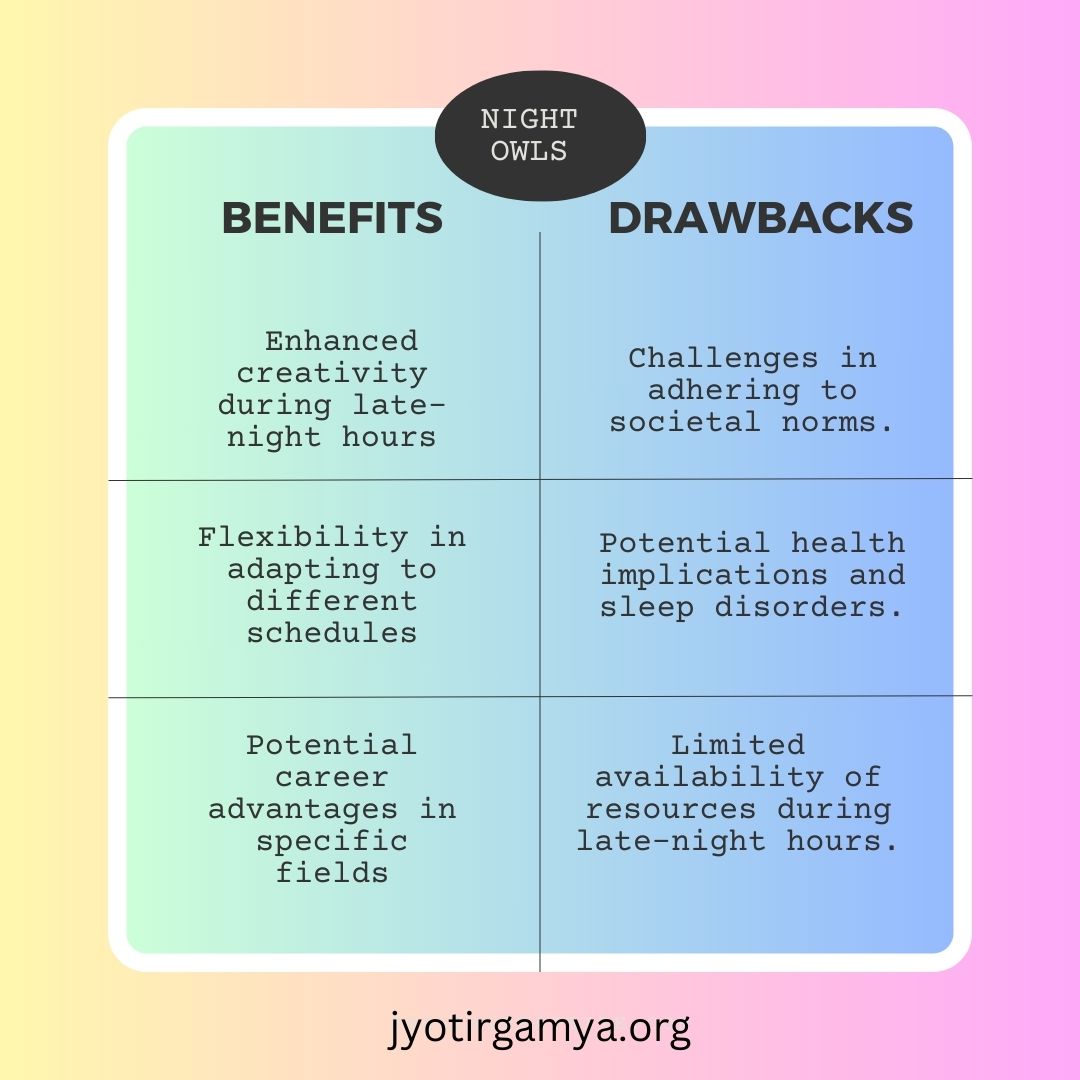
Enhanced creativity during late-night hours
Night Owls often experience a surge in creative thinking and problem-solving abilities during the late-night hours. Research conducted by Fischer and colleagues (2017) suggests that individuals with a late chronotype exhibit increased cognitive flexibility, originality, and idea generation during nighttime. This propensity for creative thinking can be attributed to the unique neurobiological and psychological processes that unfold during the night, fostering a conducive environment for divergent and unconventional thinking.
Flexibility in adapting to different schedules
Night Owls inherently possess a degree of flexibility in adapting to different schedules. Their natural inclination towards staying awake and being alert during the late hours allows them to acclimate to environments or situations that demand extended wakefulness during the night. This adaptability can be advantageous in shift work, creative industries, or occupations involving nighttime activities, where Night Owls can thrive and leverage their optimal performance during those hours.
Potential career advantages in specific fields
Specific fields and industries can provide career advantages for Night Owls. For instance, professions such as entertainment, hospitality, emergency services, and nightlife industries often operate predominantly during late-night hours. In these contexts, Night Owls can leverage their inherent nocturnal tendencies to perform optimally and excel in job roles that require late-night availability, thus capitalizing on career opportunities tailored to their chronotype.
5.4 Disadvantages of being a Night Owl
Being a Night Owl may present challenges, including adhering to societal norms, potential health implications and sleep disorders, and limited availability of resources during late-night hours.
Challenges in adhering to societal norms
Night Owls may need help adhering to societal norms due to their misalignment with conventional schedules. The prevalent social structure, primarily designed around morning-oriented activities, can create disconnection and isolation for Night Owls. Their natural inclination for wakefulness during late hours can result in conflicts with work, education, and social obligations that predominantly operate within traditional daytime frameworks.
Potential health implications and sleep disorders
Research has suggested potential health implications and increased susceptibility to sleep disorders among Night Owls. Knutson and colleagues' (2017) studies indicate a higher likelihood of developing metabolic disorders, such as obesity and diabetes, in individuals with a late chronotype. Furthermore, the misalignment between their preferred sleep-wake schedule and societal demands can contribute to sleep disorders, including delayed sleep phase disorder (DSPD), further exacerbating their health risks.
Limited availability of resources during late-night hours
Night Owls may encounter challenges related to the limited availability of resources during late-night hours. The reduced access to services, amenities, and social interactions during late-night periods can impede their daily engagement. This limitation may lead to feelings of inconvenience and limited opportunities for Night Owls, which can impact their overall quality of life.
6. Understanding Your Sleep Chronotype
Importance of identifying your sleep chronotype
Identifying your sleep chronotype is crucial in optimizing your sleep patterns and overall well-being. Sleep chronotype refers to an individual’s preferred sleep timing and natural sleep-wake patterns. Understanding your chronotype allows you to align your daily activities, work schedules, and lifestyle choices with your natural biological rhythms, improving sleep quality and enhancing cognitive and physical functioning.
Research conducted by Roenneberg et al. (2007) emphasized the importance of chronotype identification and its health implications. Individuals in sync with their chronotype experience better sleep quality, increased daytime alertness, and reduced sleep-related disorders. On the contrary, disregarding your chronotype and adopting a schedule misaligned with your natural sleep tendencies can lead to sleep deprivation, fatigue, and a higher risk of developing various health conditions, including obesity, diabetes, and cardiovascular disorders.
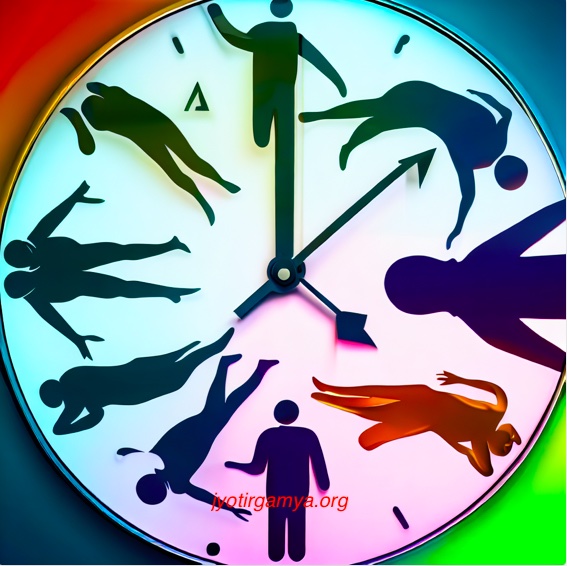
Standard methods and tools to determine your chronotype
Several methods and tools are available to accurately determine an individual’s sleep chronotype. One widely used method is the Morningness-Eveningness Questionnaire (MEQ), developed by Horne and Östberg (1976). This questionnaire consists of self-reported preferences and behavior-related questions to assess whether one leans towards being an “early bird” (morning chronotype), a “night owl” (evening chronotype), or falls somewhere in between.
Another commonly employed tool is actigraphy, which involves using a wrist-worn device to monitor sleep-wake patterns. Actigraphy records movement and light exposure data, providing valuable insights into an individual’s sleep timing and duration. Combining actigraphy with sleep logs or diaries can comprehensively understand an individual’s sleep habits and chronotype.
Potential for chronotype to change over time
While an individual’s chronotype tends to remain relatively stable throughout life, certain factors can influence his flexibility and potential for change. Age plays a significant role, as adolescents typically shift towards later chronotypes, commonly known as “night owls,” due to hormonal changes and developmental factors. However, as individuals mature into adulthood, their chronotype tends to shift back towards earlier sleep patterns.
External influences such as lifestyle, work schedules, and environmental cues can also impact chronotype. For instance, consistently adhering to a strict early morning routine may lead to a shift towards an “early bird” chronotype over time. Conversely, prolonged exposure to evening light and a night owl lifestyle can reinforce a preference for later sleep patterns.
Understanding the potential for chronotype changes allows individuals to adapt their sleep routines and make informed choices regarding their lifestyle, work schedules, and overall sleep hygiene to optimize their well-being.
7. Strategies for Managing Your Sleep Patterns Based on Chronotype
Effectively managing sleep patterns based on an individual’s chronotype can improve sleep quality, overall well-being, and productivity. Recognizing the importance of aligning our sleep routines with our innate biological preferences, this section explores practical strategies for transitioning between different chronotypes. Whether you seek to shift from being a Night Owl to an Early Bird or vice versa, these evidence-based tips offer valuable insights into adjusting sleep patterns for optimal functioning.
Tips for transitioning from a Night Owl to an Early Bird
Transitioning from a Night Owl to an Early Bird can be challenging, as it involves shifting one’s sleep-wake schedule earlier in the day. However, gradual adjustments can facilitate a smoother transition. Incrementally moving bedtime and wake-up time by 15 minutes daily can help synchronize the internal biological clock with the desired early morning schedule. Slowly shifting these timings allows the body to adapt more comfortably, minimizing the disruption to sleep patterns.
Creating a consistent sleep routine is another crucial aspect of transitioning from a Night Owl to an Early Bird. Regular bedtimes and wake-up times, even on weekends, aids in regulating the body’s internal clock. Maintaining a consistent routine reinforces the brain’s association between specific times of day and sleep, promoting better sleep initiation and maintenance. Additionally, incorporating relaxing pre-sleep rituals, such as reading or practicing mindfulness, can further facilitate the transition and signal the body to prepare for sleep.
Optimizing the sleep environment and practicing good sleep hygiene is integral to managing sleep patterns. A calm, dark, and quiet sleep environment promotes better sleep quality. Consider using blackout curtains, earplugs, or white noise machines to create a soothing atmosphere conducive to sleep. Furthermore, practicing good sleep hygiene habits, such as avoiding electronic devices before bed and limiting caffeine intake, supports healthy sleep patterns and aids in transitioning to an early morning schedule.
Tips for transitioning from an Early Bird to a Night Owl
For individuals looking to transition from an Early Bird to a Night Owl chronotype, adjusting sleep patterns to accommodate late-night productivity requires strategic approaches. Gradually shifting bedtime and wake-up time towards later hours can aid in aligning the sleep-wake cycle with the desired night owl schedule. Incrementally moving these timings by 15 minutes daily allows the body to adapt more smoothly to the adjusted schedule.
Incorporating relaxation techniques before sleep can facilitate the transition from an Early Bird to a Night Owl. Deep breathing exercises, progressive muscle relaxation, or meditation can help calm the mind and prepare it for sleep during late-night hours. These techniques assist in winding down the brain and promote a smooth transition into a night owl sleep schedule.
Adjusting lifestyle and work schedules to accommodate late-night productivity is crucial for successfully transitioning to a Night Owl chronotype. If feasible, consider restructuring work or study commitments to align with the preferred nocturnal hours. This adjustment allows individuals to optimize their productivity when they experience peak alertness and focus. By adapting the external environment to support late-night activities, individuals can enhance their performance and adjust their sleep patterns accordingly.
Specific Strategies for adjusting sleep Patterns Based on Chronotype
In addition to the tips outlined above, various other strategies can be employed to adjust sleep patterns based on an individual’s chronotype. These may include:
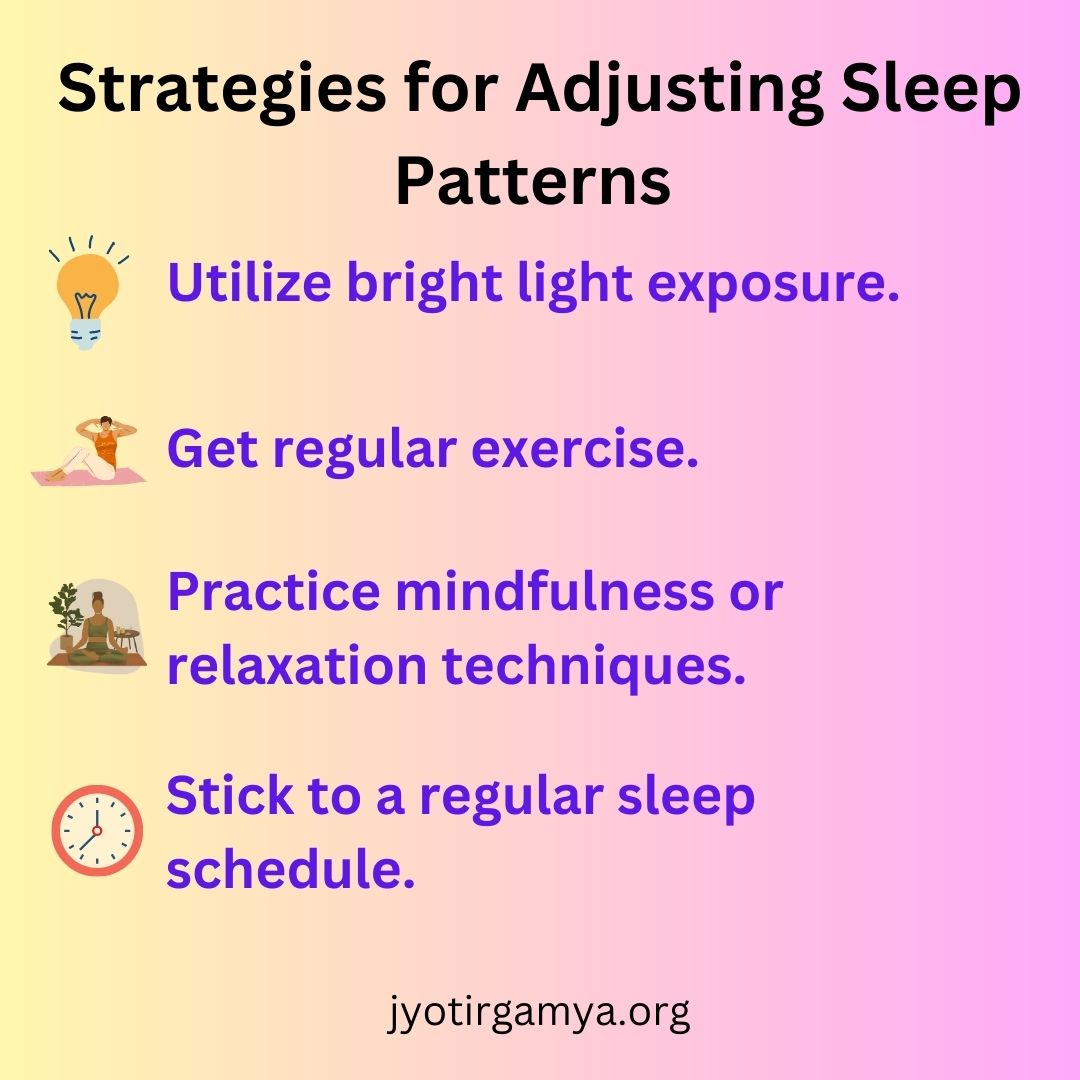
- Utilizing bright light exposure in the morning for early birds or in the evening for night owls, as light exposure plays a crucial role in regulating the circadian rhythm.
- Regular exercise routines, such as physical activity, can enhance sleep quality and promote better alignment with the desired sleep schedule.
- Practicing mindfulness or relaxation techniques, such as yoga or meditation, reduces stress and promotes relaxation before sleep.
- Seeking professional guidance, such as consulting with a sleep specialist or therapist, who can provide personalized recommendations and support throughout the transition process.
- By tailoring these strategies to individual needs and preferences, individuals can effectively manage their sleep patterns based on their unique chronotypes. This leads to improved sleep quality, enhanced productivity, and overall well-being.
8. Health Impacts of Different Chronotypes
Understanding the health impacts of different chronotypes is crucial for optimizing overall well-being. Chronotype refers to an individual’s preference for sleep timing, whether early birds or night owls. Extensive research has explored the effects of chronotype on physical health, mental well-being, and even athletic performance. We can gain valuable insights into specific chronotypes' potential health risks and benefits by delving into these areas.
Impact of Chronotypes on Physical Health
Sleep deprivation and associated health risks
Sleep deprivation has been widely recognized as a significant consequence of mismatched sleep schedules with an individual’s chronotype. Research studies have consistently shown that individuals who consistently deviate from their natural sleep preferences experience inadequate sleep duration, leading to many health risks. For instance, a study published in the Journal of the American College of Cardiology revealed that chronotype misalignment was associated with a higher risk of cardiovascular diseases, including hypertension, coronary artery disease, and stroke. These findings highlight the detrimental impact of insufficient sleep on physical health.
The link between chronotype and obesity, heart disease, and diabetes
Emerging evidence suggests a noteworthy link between chronotype and metabolic health. Studies have indicated that night owl, with a preference for late bedtimes and wake-up times, may be at a higher risk of obesity, heart disease, and diabetes than their early bird counterparts. A study published in Chronobiology International found that individuals with a delayed chronotype had a higher body mass index (BMI) and increased likelihood of obesity. Another study published in Diabetes Care demonstrated a higher prevalence of type 2 diabetes among those with an evening preference. These associations underscore the importance of considering chronotype in managing and preventing metabolic disorders.
Relationship between Chronotypes and Mental Health
Impact on mood disorders, depression, and anxiety
The influence of chronotype extends beyond physical health and extends to mental well-being. Research has shown a significant relationship between chronotype and mood disorders such as depression and anxiety. A study published in Chronobiology International examined the association between chronotype and depressive symptoms, revealing that individuals with an evening preference exhibited a higher prevalence of depressive symptoms compared to early birds. Furthermore, research by the University of Colorado Boulder discovered a higher likelihood of anxiety disorders in night owls. These findings emphasize the need to consider an individual’s chronotype when assessing mental health and designing appropriate interventions.
Role of Chronotype in sleep disorders and mental health conditions
Chronotype plays a substantial role in developing and manifesting sleep disorders and other mental health conditions. Research has demonstrated that individuals with a delayed chronotype are more prone to experiencing difficulties falling asleep and maintaining regular sleep-wake schedules. For example, a study published in the journal Sleep Medicine reported a higher prevalence of delayed sleep phase disorder (DSPD) among night owls, characterized by an inability to fall asleep and wake up at conventional times. Additionally, individuals with a delayed chronotype may face challenges adapting to societal schedules, leading to heightened stress levels and potential negative impacts on mental health.
The Role of Chronotype in athletic performance
Beyond physical and mental health, chronotype also influences athletic performance. Research has explored the impact of chronotype on athletes' training, competition, and recovery. A study published in the Journal of Sports Sciences examined the association between chronotype and performance among elite athletes, revealing that morning types demonstrated improved performance in morning training sessions. In contrast, evening types displayed enhanced performance during evening competitions. These findings suggest that considering an athlete’s chronotype can help optimize training schedules and maximize performance outcomes.
9. Conclusion
Understanding and embracing our sleep chronotype, whether Early Birds or Night Owls, is crucial for optimizing our sleep quality and overall well-being. Recognizing the differences in sleep patterns and preferences between these two chronotypes allows us to align our daily routines with our natural inclinations. Doing so can unlock enhanced productivity, improved mental and physical health, and greater satisfaction.
Optimizing sleep habits based on our chronotype yields numerous benefits, including improved cognitive performance, mood regulation, and physical health. Adhering to our natural sleep preferences leads to higher alertness, better executive functioning, and reduced risk of sleep disorders. It positively impacts our immune system, cardiovascular health, and metabolic function. By recognizing the importance of sleep and tailoring our routines accordingly, we can enhance daily performance and promote long-term health outcomes.
Understanding sleep chronotypes highlights the significance of individual differences and the value of embracing our uniqueness. Respecting diverse sleep preferences fosters inclusivity and a holistic perspective on well-being. By accommodating diverse needs, we can create environments and structures that promote optimal functioning for all individuals. Embracing our uniqueness extends beyond sleep patterns and contributes to the richness of human experiences, enabling us to thrive collectively as a society.
Related Articles:
That’s all in this edition.
If you liked reading the article, do share it with folks who would benefit from it.
Want to stay connected? Here’s our twitter.